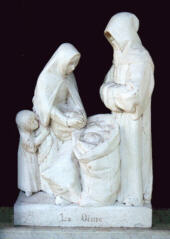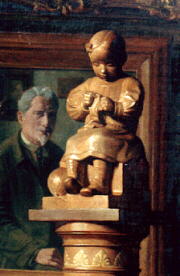| He admired
the Middle Ages very much and many of his works were
inspired by that time : Saint Francis
speaking to the birds (1894), Woman holding a book
(circa 1895), Saint Cecilia (1896), Burgess
and Scholar (1896), Inquisitor (1897),
which Rodin wished to purchase but which G.
Schnegg refused to surrender, Storm (1898), Gothic
Maternity
(ca 1898), Tithe (ca 1902), Singing (ca 1910),
Talk (ca 1911). Several of theses works can be seen on the blog of the Despiau-Wlérick Museum in Mont-de-Marsan, in the vitrine dedicated to the Schnegg brothers. |
 |
Tithe, plaster cast ----- A marble group |
